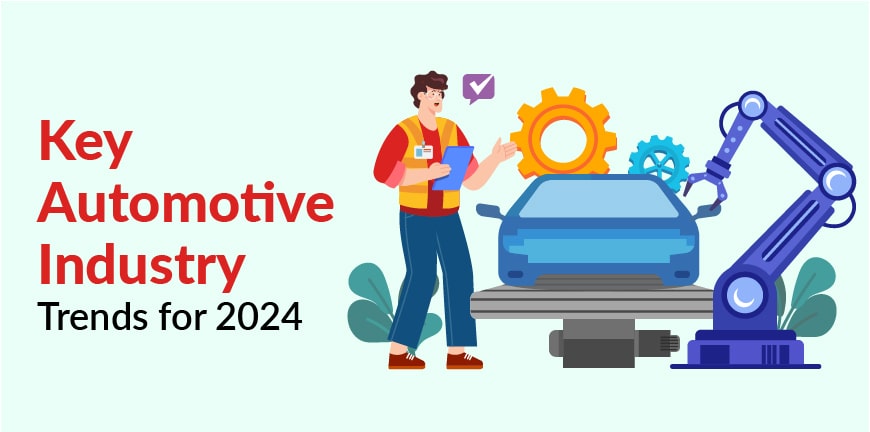
5 Ways in Which HR Can Benefit from ChatGPT
27/11/2023
Difference between HRM and IHRM
06/12/2023The automotive industry undoubtedly had a major setback in the past couple of years due to the impact of COVID-19. But the latest automotive industry trends have shown major indications that they are ready to get back on their feet and how.
The automotive technology market size is likely to reach USD 69.18 billion in 2023 and is anticipated to cross the mark of USD 100 billion by 2028 growing at a CAGR of 8.21% during the forecast period (2023-2028).

There were a few obvious roadblocks due to the prevailing conditions, but the industry will soon be seeing some exciting times with increased adoption of EV and car manufacturing industries introducing IoT (Internet of Things) features in automobiles, hydrogen-driven cars, etc.
What do you mean by Automotive Industry Trends?
Automotive trends are the developments, changes, modifications, and patterns taking place in the automotive industry that can impact some major aspects such as design, production, marketing, and usage of vehicles.
What drives these trends?
The rapidly changing times have been demanding better, evolved upgrades in the automobile sector. Some of the major factors that are driving these latest trends are technological advancements, changing consumer preferences, and global economic conditions.
Some of the common areas of focus for automotive industry trends include electric vehicles, connectivity, mobility solutions, sustainability, sales, and distribution models. To penetrate the emerging market like the increasing adoption of electric vehicles in China and India, it is important to follow these trends.
Top 10 automotive industry trends and innovations for 2024
1. Autonomous Vehicles (AVs)
Self-driving or autonomous vehicles have been the talk of the town since the idea surfaced, while some parts of the country have successfully executed the idea into reality, there are many others that are yet to start.
Let us talk about why AVs have created such hype.
AVs can eliminate or minimize the need for human intervention and can transform everyday transportation. AVs can-
- The ease of last-mile deliveries
- reduces downtime.
- Improved fuel efficiency
- help implement safer public transportation
For example, if a driver is showing signs of fatigue or neglect, there is a higher risk of causing an accident. Advanced recognition technologies, like AI (Artificial Intelligence) enhanced computer vision (identifies obstacles) can help avoid these mishaps.
Here are some significant examples of AVs that have already been implemented-
- US-based startup FlxTran has developed a new transportation system using self-driving vehicles on abandoned railroad tracks to provide fast regional transport to connect smaller communities.
- Another US-based startup Udelv has been successfully providing autonomous vehicles for last-mile deliveries. It combines advanced AI algorithms and hyper-speed teleoperations for human-assisted guidance in unique situations.
2. Digital technology-equipped vehicles
Tech giants like Google and Tesla have been striving to incorporate more digital technology into their cars. This has pushed other companies into a competitive stride into developing automotive software and digital systems that can power and control innovative electric vehicles.
While 2023 has seen a glimpse of digitally equipped cars, 2024 will see more of them come to life and in action.
3. Rise in Digital Automobile Sales (VR tech adoption)
In parts of North America and Europe, automobile manufacturers have helped customers skip an in-person visit to the dealership and facilitated an online pick or purchase. With a computer or smartphone, buyers can shop at their convenience, explore, and select the features they want on a car, and select their financing options to pay for the car. Dealerships have also started offering online sales which-
- Let us as online buyers use virtual walk-around technology (VR tech)
- Facilitates at-home test drives
- Do home delivery of vehicles they sell
4. More connected cars
Connected cars are connected to the IoT using wireless technology. With connected cars, you will get a multimedia experience in the comfort of your car. By using on-demand features, you can explore anything on the web while sitting in your vehicle.
Startups and scaleups develop vehicle connectivity solutions that enable them to connect and exchange data with other vehicles (V2V), an electric vehicle grid (V2G), public infrastructure (V2I), as well as with new and emerging ways to utilize vehicle data (V2X).
Connected Cars can-
- Communicate bidirectionally with other systems outside their local area network
- Share internet access and data with devices inside and outside the car
- Send digital data and remote diagnostics, vehicle health reports, and data-only telematics, access 4G LTE Wi-Fi Hotspots, get turn-by-turn directions, warn of car health issues, and directly intervene to prevent breakdowns.
5. Rise in Fuel Cell Electric Vehicles
Fuel-cell electric cars are a phenomenal invention that is set to offer benefits way beyond your expectations. Electric vehicles release 54% fewer CO2 emissions into the atmosphere than even the newest gas-powered vehicles.
Some of the advantages of fuel-cell electric cars are-
- They can Recharge faster
- Have up to 5 times the range of other electric vehicles
- Emit water only from their tailpipes
Some of the biggest car, truck, and SUV manufacturing countries like China, Japan, South Korea, and the United States are fully backing the fuel cell electric auto technology.
German startup ChargeX offers a modular EV charging solution that converts parking spaces into charging stations.
6. Shared mobility
This all-new business model has grown in popularity rapidly in recent years owing to factors like cost efficiency, reduced carbon emissions, and convenience.
What is shared mobility? In this type of model, two or more people use the same vehicle with short-term access. Its mobility is a service that people use as a personal rental.
New companies have been increasingly offering shared mobility options, creating a creative, affordable, and convenient alternative to vehicle ownership’s inflated costs and many responsibilities.
Singapore-based startup Beam has released e-scooters to promote shared mobility in the Asia-Pacific region. These scooters use an aviation-grade aluminum frame and are customized for sharing, safety, reliability, and durability.
7. Increased sales of pre-owned vehicles
Used car sales have always been popular. Experts in the industry anticipate a 9% growth rate in used car sales between 2019 and 2025. Pre-owned vehicles, hybrid, and electric models have many of the latest automotive features and are not as expensive as new ones.
Dealerships have huge inventories of certified pre-owned cars that are as good as new but cost a lot less than brand-new ones. Another attractive feature of pre-owned cars is Low APR financing.
8. Truck Platooning
Truck platooning is when multiple trucks drive close to one another while traveling at high speeds to achieve vehicle-to-vehicle connectivity. Truck platooning is set to become increasingly common because research has shown that when trucks move in this type of formation, they exponentially increase fuel efficiency.
The self-driving truck market globally is anticipated to be over $1,699 billion by 2025. About 50% of small businesses say truck fleets will be completely self-driving in 20 years. With autonomous self-driving vehicles (trucks included) becoming more commonplace on the road, so will truck platooning.
9. Automakers collaborating with tech companies
The constantly evolving tech requirements in vehicles have nudged automakers and tech companies to form partnerships. This is crucial, especially for electric, connected, and autonomous vehicles that make use of advanced technology to function safely.
The partnership will help manufacturers avoid the massive investments they have to make in the tech division. Tech companies can take over the functions of design and production of new operating systems required for the next generation of technologically advanced vehicles.
10. Upgradation of built-in messaging apps and voice search
Chatbots and messaging solutions are key technology trends in the automotive industry. New customers are always anxious and are keen on knowing every detail, whether the pros or cons of the car they are buying, and rightfully so. Answering every question of every customer to their satisfaction in person can get tedious for the sales teams at dealerships.
With chatbots and messaging apps, dealerships can
- Handle inquiries efficiently, freeing time for other tasks
- Facilitate the management of maintenance and repair appointments, streamlining dealership operations.
- Optimize their interface for advertisements and voice search queries.
Gear Up for the Revolution
This revolution is not without its challenges, including cybersecurity concerns, regulatory adjustments, and the need for infrastructure upgrades. Nevertheless, these transformative trends signify a commitment to innovation, with the potential to make transportation more efficient, safer, and environmentally conscious.
The revolution in automotive trends marks a transformative era in the way we perceive, interact with, and utilize vehicles. From the rise of electric and autonomous vehicles to the integration of advanced connectivity and smart technologies, the automotive industry is undergoing a profound shift.
This revolution not only addresses environmental concerns with the promotion of sustainable mobility but also redefines the driving experience, safety standards, and overall transportation infrastructure.
Contact Us For Business Enquiry

Rajkumar Shanmugam
Rajkumar Shanmugam is the Head of HR at ALP Consulting, bringing over 19 years of comprehensive HR leadership experience across India and international markets. His expertise spans talent acquisition, employee relations, performance management, compliance, and HR transformation. Rajkumar has a proven track record of driving people-centric initiatives, enhancing workplace culture, and aligning HR strategy with business goals. With extensive experience in US staffing operations and global mobility, he continues to lead organizational excellence through innovation and employee engagement.




